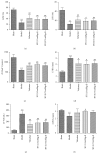Cardioprotection against Heart Failure by Shenfu Injection via TGF- β/Smads Signaling Pathway
- PMID: 28698735
- PMCID: PMC5494069
- DOI: 10.1155/2017/7083016
Cardioprotection against Heart Failure by Shenfu Injection via TGF- β/Smads Signaling Pathway
Abstract
Objective: To explore the potential cardioprotective mechanism of Shenfu injection (SFI) against heart failure (HF) by attenuating myocardial fibrosis and cardiac remodeling.
Methods and results: Four weeks after myocardial infarction (MI), adult male Sprague Dawley rats were randomized for 4-week treatment with Valsartan, SFI, or vehicle. Echocardiography and hemodynamics were applied to evaluate cardiac functions. Myocardia of coronary artery ligated (CAD) rats were observed to investigate changes in cardiac structure and function. Our findings suggest that treatment with SFI could inhibit progression of myocardial fibrosis and attenuate cardiac remodeling. In addition, SFI decreased expression of Smad2 and Smad3, while increasing the expression of Smad7 through regulation of TGF-β/Smads signaling pathway.
Conclusion: Treatment with SFI in Sprague Dawley rats improves ventricular structure and function and reduces cardiac fibrosis by ameliorating TGF-β/Smads signaling pathway after ventricular remodeling.
Figures









References
-
- McMurray J. J. V., Adamopoulos S., Anker S. D., et al. ESC guidelines for the diagnosis and treatment of acute and chronic heart failure 2012: the task force for the diagnosis and treatment of acute and chronic heart failure 2012 of the european society of cardiology. Developed in collaboration with the heart Failure Association (HFA) of the esc. European Heart Journal. 2012;33(14):1787–1847. doi: 10.1093/eurheartj/ehs104. - DOI - PubMed
-
- Yancy W. C., Jessup M., Bozkurt B., et al. 2013 ACCF/AHA Guideline for the management of heart failure: a report of the American College of Cardiology Foundation/American Heart Association Task Force on Practice Guidelines. Circulation. 2013;128:e240–e327. doi: 10.1161/CIR.0b013e31829e8776. - DOI - PubMed
-
- Gu D., Huang G., He J., et al. Investigation of prevalence and distributing feature of chronic heart failure in Chinese adult population. Chinese Journal Cardiology. 2003;31(1):3–6.
-
- Radford M. J., Arnold J. M. O., Bennett S. J., et al. ACC/AHA key data elements and definitions for measuring the clinical management and outcomes of patients with chronic heart failure: a report of the American College of Cardiology/American Heart Association Task Force on Clinical Data Standards (Writing Committee to Develop Heart Failure Clinical Data Standards) Circulation. 2005;112(12):1888–1916. doi: 10.1161/CIRCULATIONAHA.105.170073. - DOI - PubMed
LinkOut - more resources
Full Text Sources
Other Literature Sources
Research Materials
Miscellaneous

